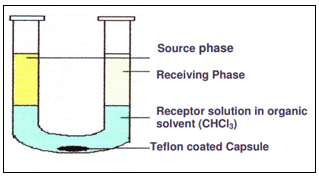Extraction and Bulk Liquid Membrane Transport of Charbohydrate ,Glucose, Fructose, Lactose Across Artificial Liquid Membrane System Using Anthraquinone Derived Podands
Keywords:
Bulk liquid membrane, Bibracchial receptorsAbstract
Redo switched anthraquinone derived podands 1-(1- anthraquinonloxy), 3, oxapentane – 5 – methane (T1), 1,5 bis (2-(2-(2- hydroxyethoxy) ethoxy)ethoxy)anthracene-9-10 dione (T2),1, 5 bis-(2-(2-hydroxyethoxy) ethoxy) ethoxy) anthracene-9-10 dione (T3) have been synthesized by condensation of chloroanthraquinone,1,5dichloroanthraquinone with triethylene glycol, diethylene glycol,methoxy methanol in THF under N2 atmosphere. The characterization has been done by m.p., TLC and IR, NMR spectral analysis. These receptors used for the liquid-liquid extraction, bulk liquid membrane transport of glucose, fructose, lactose. The trend observed for extraction of sugar with these receptors is lactose>glucose.>fructose and that for is fructose>glucose>lactose. Among all receptors T3 shows higher extraction and transport than T2, T1 due to more number of donor sites in T3 Bibracchial receptors are good extractant but poor carrier than single armed receptor. Extraction and transport ability enhanced in reduced state.
References
Smith B.D., Gardiner S.J., J.Am.Chem.Soc., 188, 1996, 11093.
Takeuchi M., Goto M., Tetrahedron, 52, 1996, 12931.
Nakamura M., Saka moto H., Kimura K., Anal. Science, 21, 2005, 403-407.
Atwood L.J., Gokel, W.J., J.Org. Chem., 56, 1991, 7059, 7065
Sawhney S.K., Introductory Practical Biochemistry, Narosa Publication, 1996.
V. Vyas, A. Vani, U. Sharma, Main Group Met. Chem., 31, 2008,283-288 .
J. Tomar, A. Awasthy and U. Sharma, Desalination, 232, 2008, 102-109.
Diamond C.J., Dihong D.M., J. Chem. Soc. Chem. Commun., 105, 1980, 1053
Smith D.B., Pamela R., J. Am. Chem. Soc., 118, 1996, 11093-11100.
Pletnev L.V., Russian Chem. Bull., 47, 1998, 1
Smith B.D., Litchefield R.K., J.Org. Chem., 61, 1996, 1148-1150

Downloads
Published
How to Cite
Issue
Section
License

This work is licensed under a Creative Commons Attribution 4.0 International License.
Authors contributing to this journal agree to publish their articles under the Creative Commons Attribution 4.0 International License, allowing third parties to share their work (copy, distribute, transmit) and to adapt it, under the condition that the authors are given credit and that in the event of reuse or distribution, the terms of this license are made clear.





